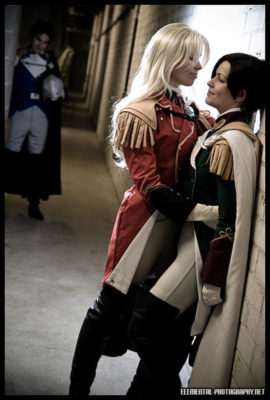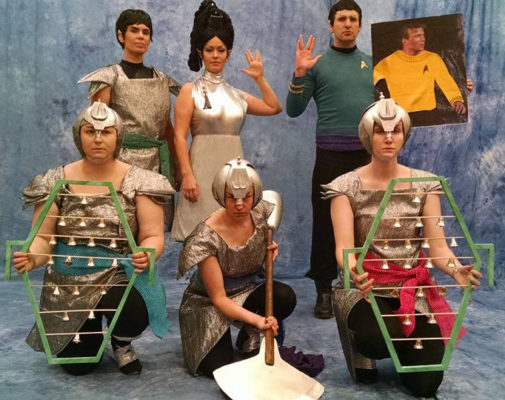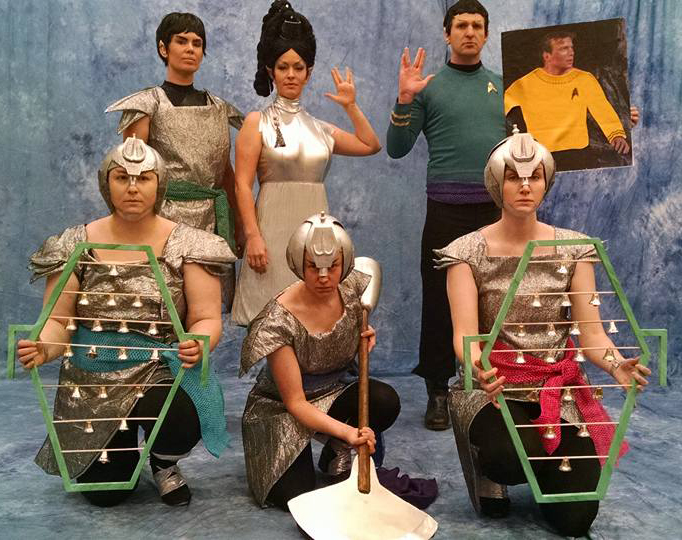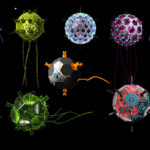Cosplay 101 For The Confused Christian
About a decade ago, my then-pastor included cosplay photos of my cosplay group in the church bulletin, just because he thought it was unusual and would be fun.
He didn’t know it, but that decision made for years of easier connection with friends leery of organized religion.
They told me, “You go to church? Don’t they, you know, get all weird about you going to cons and stuff?”
“Actually, they put our cosplay photos in the bulletin,” I said.
“Really?”
This was so unexpected that it broke preconceptions and barriers.

The photo which was selected for a calendar and brought criticism in my small group.
About the same time, however, I arrived at small group one night to hear the co-leader publicly sharing her disgust at the “lesbian incest” photos she’d seen online of my sister and me, cosplaying a straight and unrelated couple. This disparagement didn’t build many relationships within the church or without.
From outside the hobby, cosplay can look confusing or even a little scary in its unfamiliarity, but it doesn’t have to be either. Here’s a quick overview of the community and a guide to key terms.
Cosplay means dressing up as particular characters (or occasionally concepts or inanimate objects!) from a particular media source.
The word is a portmanteau of “costume playacting.” And while the act is often touted as a modern fandom thing, it actually goes back at least to the 1930s in its recognizable modern form.
It’s no different than what a previous generation did when they donned coonskin caps because Daniel Boone was big on television. Fans have always wanted to take on the look of their favorite characters! Cosplay often involves being in character to a greater or lesser degree. While most cosplay purely for fun, there are competitions for craftsmanship and performance, ranging from local to international.
Crossplay means portraying a character of the opposite sex.
When I as a woman play Edward Elric or Emperor Ryuuki, for example, I am crossplaying. When a male friend plays Daphne from Scooby Doo, he is crossplaying. The character’s sex is not the cosplayer’s sex.

Our “Amok Time” group, from Star Trek.
There are many reasons a cosplayer might crossplay:
- A group needs characters which don’t match the group’s makeup. A few weeks ago, for example, friends and I played the Vulcans from the iconic Star Trek episode “Amok Time,” even though there was only one male cosplayer in our group. Most of us females crossplayed to fill out the roles.
- A cosplayer wants to play to their own physical or mental attributes. I once judged a real-life male and female couple playing an onscreen male and female couple—but he was playing the female and she was playing the male, because they were each better suited for those roles. They earned a prize for their excellent craftsmanship and portrayals.
- Frankly, women often crossplay because there are more worthwhile male characters than female. The trope of the five-man band can keep female characters to a minimum, and there are a lot of bland women and “sexy lamps” in media. I often play male characters simply because they’re the interesting ones.

My sister Alena, playing Nathan Drake from Uncharted.
While many people are tempted to view male-to-female cosplay as a joke, that’s not fair (and it says a great deal about one’s gender views). I’ve seen a lot of very talented male cosplayers make beautiful costumes and do a fantastic job playing female characters. Mocking or denigrating them, or assuming their purpose could only be comic, is just as boorish as laughing at a male author who writes a female protagonist.
Crossplay can be done very skillfully. My sister and I have both been asked to dance by women while playing men, and my friend Christopher has more than once been mistaken for a woman until he speaks—and we all laugh together and they complement our efforts. It means we’ve done our work well!
Gender-bending is when the character changes sex—but not the cosplayer.
An example might be a woman playing the Tenth Doctor as a woman, wearing a pin-striped skirt and jacket and heels. I saw a WonderMan at an event last month, wearing adapted armor. The character and costume have been gender-swapped, but the cosplayer and gender-bent character have the same sex. This may be done when a cosplayer doesn’t feel confident in his or her crossplay abilities or just when he or she wants to reimagine a character with a different take.
Observers sometimes make a serious mistake by assuming crossplay and gender-bending are declarations of sexual preference or practice.
I play more male characters than female, and I’m a straight woman who’s been married nearly 20 years. Gay and straight cosplayers cosplay, crossplay, and gender-bend in equal ratio. The couple jointly crossplaying a couple was not practicing some sort of fetish. Making an assumption about someone’s sexual practices at home based on a costume is just as uncouth as at any other time, and commenting on it is just as unwelcome and creepy at a cosplay event as it would be on a sidewalk or at church.
While cosplay generally incorporates a variety of construction skills, from sewing to armor-making to casting to wig-making, it doesn’t have to be that complicated.
Closet cosplay is the art of taking the clothes you already own and incorporating them into a costume.
This is a concept already familiar to Sunday School parents, wrapping their children in bathrobes and towels for the annual Christmas pageant. But it’s also useful for the novice cosplayer without many sewing or construction skills. It’s best for characters whose looks are based on modern street clothes; a solid-colored shirt with suspenders, a Hawaiian shirt, and a silky dress can quickly become Malcolm Reynolds, Wash, and Inara from Firefly. It’s somewhat less feasible for, say, a Gundam or a kaiju from Pacific Rim.
Now that we have some basic terminology, we can talk about common misapprehensions and myths. Tune in again next week for Cosplay 101 for the Critical Christian, where we’ll learn what all this really says about the people who engage in this colorful hobby, and what to watch for.









































Well explained! I already knew the differences in crossplay and gender-bending but it was something I’ve just picked up over the years. I’d never really analyzed it before so it was interesting to have it so well-defined. 🙂 Cosplay is something I’d really like to do someday.
That cosplay was Oscar and whathisface (Jean?) from “Rose of Versailles,” isn’t it? (‘Splainer: the plot is that Oscar is a woman who was raised as a man and is a remember of the royal guard to Marie Antoinette.)
I have a Facebook-acquaintance who crocheted her arm-cover for her Edward Elric cosplay, and even did it in pieces rather than just a sleeve. A+ yarnwork.
Do you mean the top photo? That’s actually Lucrezia Noin, Zechs Merquise, and Treize Kushrenada from Gundam Wing. But keep an eye open next week for a French Revolution-era costume from The Scarlet Pimpernel!
That’s great, re your friend who crocheted the automail. 🙂
If I ever get further into cosplay than just cloaking, I’ll show this to my mom.
Okay, so at my college we had an unoffical group of ‘cloakers’. It wasn’t cosplay as such (we weren’t pretending to be anyone else), but whoever on campus had cloaks would just wear them around campus, particularly on prospective student days.
We were even in our campus news video once: https://youtu.be/1Vfc281HhHo (opening segment to 2:11 or so)
Your link to part 2 is broken